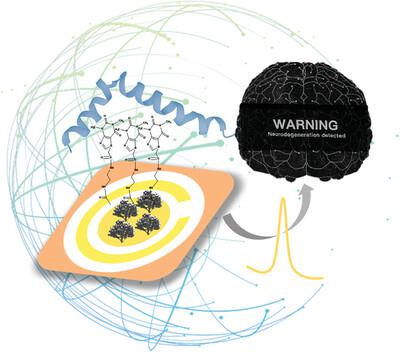Portable non‐enzymatic electrochemical biosensor based on caffeine for Alzheimer's disease diagnosis
IF 8.5
4区 医学
Q1 MATERIALS SCIENCE, BIOMATERIALS
引用次数: 0
Abstract
Abstract Caffeine and its derivatives can effectively bind amyloid beta 16–22 (Aβ 16–22 ) fragment of amyloid beta 1–42 (Aβ 1–42 ), a biomarker for the early diagnosis of Alzheimer's disease (AD), by means of conformation selection, π–π stacking, van der Waals forces, and hydrogen bonding, so as to achieve high specificity and quantitative detection of Aβ 1–42 . In this study, 3‐mercaptopropionic acid (MPA), conductive polymer poly(thiophene‐3‐acetic acid) (PTAA), and pine‐like/Au pine PTAA (pine PTAA) were applied to modify the electrodes, and the non‐enzymatic caffeine was used as specific biorecognition element to study the analytical performance of the electrochemical sensor platform for Aβ 1–42 oligomer (AβO). It was found that caffeine/pine PTAA‐based sensor with large surface area, high active sites, and excellent electrical conductivity demonstrated the widest linear range (10 −8 to 100 nM) and highest sensitivity (743.77 Ω/log nM) in comparison. The prepared caffeine‐based sensor was afterward applied to cerebrospinal fluid and blood tests for real sample analysis, demonstrating its potential for practical use in detecting AβO at the attomolar level. Furthermore, the non‐enzymatic caffeine was constructed on the pine‐like PTAA‐modified screen‐printed electrodes for the rapid detection of AβO using portable meter.

基于咖啡因的便携式非酶电化学生物传感器用于阿尔茨海默病诊断
咖啡因及其衍生物可通过构象选择、π -π叠加、范德华力和氢键等手段,有效结合阿尔茨海默病(AD)早期诊断生物标志物β 1-42 (a β 1-42)的β 16-22 (a β 16-22)片段,实现对β 1-42的高特异性和定量检测。本研究采用3 -巯基丙酸(MPA)、导电聚合物聚噻吩- 3 -乙酸(PTAA)、类松/Au松PTAA (pine PTAA)对电极进行修饰,并以非酶性咖啡因作为特异性生物识别元件,研究了电化学传感器平台对Aβ 1-42低聚物(Aβ o)的分析性能。结果表明,基于咖啡因/松树PTAA的传感器具有较大的表面积、较高的活性位点和优异的导电性,具有最宽的线性范围(10−8 ~ 100 nM)和最高的灵敏度(743.77 Ω/log nM)。所制备的基于咖啡因的传感器随后应用于脑脊液和血液测试,用于实际样品分析,证明了其在检测原子摩尔水平上的AβO的实际应用潜力。此外,将无酶咖啡因构建在PTAA修饰的松状丝网印刷电极上,用于便携式仪器快速检测AβO。
本文章由计算机程序翻译,如有差异,请以英文原文为准。
求助全文
约1分钟内获得全文
求助全文
来源期刊

VIEW
Multiple-
CiteScore
12.60
自引率
2.30%
发文量
0
审稿时长
10 weeks
期刊介绍:
View publishes scientific articles studying novel crucial contributions in the areas of Biomaterials and General Chemistry. View features original academic papers which go through peer review by experts in the given subject area.View encourages submissions from the research community where the priority will be on the originality and the practical impact of the reported research.
 求助内容:
求助内容: 应助结果提醒方式:
应助结果提醒方式:


